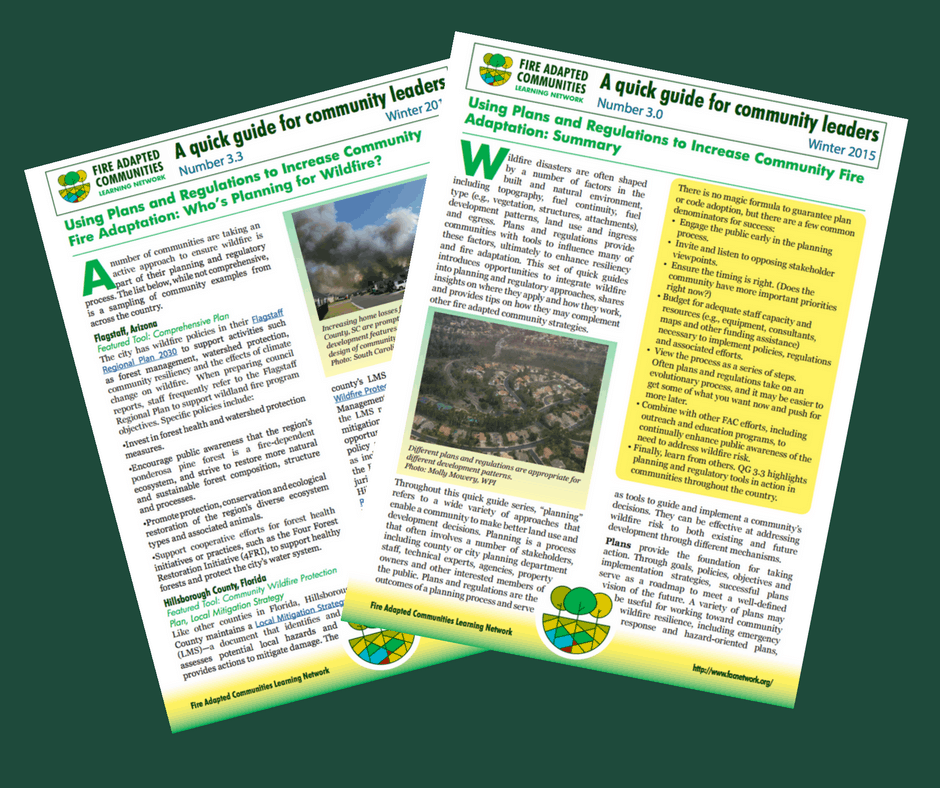Photo Credit: A recent planning for wildfire webinar featured how Ashland, Oregon expanded its wildfire hazard zone to include the entire city. Photo by Al Case via Flickr Creative Commons
In this post, I highlight five of Fire Adapted Communities Learning Network (FAC Net)’s most helpful planning for wildfire resources. Fire adapted communities take action before, during and after a wildfire. An important component to the “before” actions involves municipal planning, which includes codes and ordinances, as well as other processes that integrate wildfire risks, preparedness and response needs into local plans.
1. Working with a Local Planner? Share the “Planning for Wildfire” Quick Guides!
Quick Guides are short handouts designed for practitioners and community leaders; they introduce a topic and provide short stories and additional resources. The “Planning for Wildfire” Quick Guide series is a four-part resource on using plans and regulations to increase community fire adaptation. Its corresponding handouts can be shared electronically, or as printed copies.
The first handout in the series, Quick Guide 3.0 introduces the differences between plans and regulations and offers related resources. Quick Guide 3.1 highlights a three-step process to identify and increase linkages between wildfire topics and planning documents. Quick Guide 3.2 discusses how plans are implemented through regulations and offers additional steps to move through this process. Lastly, Quick Guide 3.3 shares a range of community examples, including sample policies and regulatory language, as well as links for additional learning.

Click here to access Quick Guide 3.0, Using Plans and Regulations to Increase Community Fire Adaptation: Summary, here!
2. Looking for more examples? Check out this recent webinar recording.
A group of FAC Net members formed a community of practice (CoP) last year focused on planning for wildfire. Recently, the Planning for Wildfire CoP held a webinar featuring city and county planners from Texas, New Mexico and Oregon. The goal of the webinar was two-fold. Participants learned about how these planners incorporate planning for wildfire into their work. And, participants had the chance to ask questions about engaging their own communities’ planners and discuss what’s worked well and what hasn’t.
The webinar featured:
- Brandon Goldman, senior planner from Ashland, Oregon, explained Ashland’s efforts to establish the entire city as being within a wildfire hazard zone;
- Anthony Raguine, senior planner from Deschutes County, Oregon, highlighted new developments in Deschutes County that have more comprehensive wildfire protection management plans;
- Noah Berke, senior planner from the City of Santa Fe, New Mexico, discussed integrating the wildland-urban interface (WUI) code into Santa Fe’s land use development code in order to make the city’s WUI language enforceable;
- Steve Hopkins, senior planner from Austin, Texas, shared the challenges of working in a large city and discussed their efforts to get Austin’s WUI code adopted.
Watch the webinar recording to learn about how these communities are planning for wildfire:
3. Thinking about long-term recovery planning? Read this blog.
FAC Net Members from Oregon and Washington recently hosted a learning exchange exclusively focused on this very topic. Get tips and resources on cultivating long-term recovery after a wildfire by reading this blog about the exchange: Long-term Recovery Planning: Where We Started.
Two other great blogs that focus on additional considerations regarding planning for wildfire are:
- Small Business Planning for Wildfire and
- Working with Communities to Reduce Wildfire Risk Through Planning
4. Working on a Community Wildfire Protection Plans? Watch these videos.
Three different communities discussed the development and implementation of their Community Wildfire Protection Plans (CWPPs) last year. The following presentations are clips from those presentations and offer best practices, creative ideas and how-to’s.
- Lake Tahoe CWPP (California);
- Austin CWPP (Texas);
- Greater Bend CWPP (Oregon)
5. Assessing your own wildfire resilience? Check out the FAC SAT!
If you haven’t done so already, take a look at the FAC Self-Assessment Tool (FAC SAT). The FAC SAT asks questions about your community’s wildfire hazard, values at risk, mitigation activities, public engagement and partnerships. This information-gathering process enables communities to:
- Identify their community’s values at risk;
- Identify their community’s capacity to implement FAC activities;
- Assess any gaps or limitations in funding, resources, partnerships and workforce/volunteers;
- Prioritize future fire adaptation activities;
- Complement other work plans; and
- Increase understanding of long-term community fire adaptation needs.
Be sure to also check out the FAC Sat’s Facilitator’s Guide for more information about the FAC Sat and how to get started.
What Else?
What other resources would you like to see around wildfire planning? Do you have success stories about wildfire planning in your community? Share your thoughts in the comments below!
Please note that comments are manually approved by a website administrator and may take some time to appear.


I found the watershed quick guides to be very interesting and inspiring starting out in FAC Net. For anyone who could be addressing wildfire risk at a watershed scale, I highly recommend them!
Glad to hear that, Becca! Here is the link to those Quick Guides for anyone interested: https://fireadaptednetwork.org/resource/increasing-watershed-resilience-to-promote-fire-adapted-communities-summary-1-of-4/